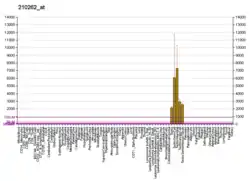CRISP2
Cysteine-rich secretory protein 2 is a cysteine-rich secretory protein that in humans is encoded by the CRISP2 gene.[5][6][7]
| CRISP2 | |||||||||||||||||||||||||
|---|---|---|---|---|---|---|---|---|---|---|---|---|---|---|---|---|---|---|---|---|---|---|---|---|---|
| |||||||||||||||||||||||||
| Identifiers | |||||||||||||||||||||||||
| Aliases | CRISP2, CRISP-2, CT36, GAPDL5, TPX1, TSP1, cysteine rich secretory protein 2 | ||||||||||||||||||||||||
| External IDs | OMIM: 187430 MGI: 98815 HomoloGene: 37756 GeneCards: CRISP2 | ||||||||||||||||||||||||
| |||||||||||||||||||||||||
| |||||||||||||||||||||||||
| |||||||||||||||||||||||||
| Orthologs | |||||||||||||||||||||||||
| Species | Human | Mouse | |||||||||||||||||||||||
| Entrez | |||||||||||||||||||||||||
| Ensembl | |||||||||||||||||||||||||
| UniProt | |||||||||||||||||||||||||
| RefSeq (mRNA) |
| ||||||||||||||||||||||||
| RefSeq (protein) |
| ||||||||||||||||||||||||
| Location (UCSC) | Chr 6: 49.69 – 49.71 Mb | Chr 17: 40.76 – 40.81 Mb | |||||||||||||||||||||||
| PubMed search | [3] | [4] | |||||||||||||||||||||||
| Wikidata | |||||||||||||||||||||||||
| |||||||||||||||||||||||||
References
- GRCh38: Ensembl release 89: ENSG00000124490 - Ensembl, May 2017
- GRCm38: Ensembl release 89: ENSMUSG00000023930 - Ensembl, May 2017
- "Human PubMed Reference:". National Center for Biotechnology Information, U.S. National Library of Medicine.
- "Mouse PubMed Reference:". National Center for Biotechnology Information, U.S. National Library of Medicine.
- Kasahara M, Gutknecht J, Brew K, Spurr N, Goodfellow PN (Mar 1990). "Cloning and mapping of a testis-specific gene with sequence similarity to a sperm-coating glycoprotein gene". Genomics. 5 (3): 527–34. doi:10.1016/0888-7543(89)90019-0. PMID 2613236.
- Kratzschmar J, Haendler B, Eberspaecher U, Roosterman D, Donner P, Schleuning WD (Aug 1996). "The human cysteine-rich secretory protein (CRISP) family. Primary structure and tissue distribution of CRISP-1, CRISP-2 and CRISP-3". Eur J Biochem. 236 (3): 827–36. doi:10.1111/j.1432-1033.1996.t01-1-00827.x. PMID 8665901.
- "Entrez Gene: CRISP2 cysteine-rich secretory protein 2".
External links
- Human CRISP2 genome location and CRISP2 gene details page in the UCSC Genome Browser.
Further reading
- Maruyama K, Sugano S (1994). "Oligo-capping: a simple method to replace the cap structure of eukaryotic mRNAs with oligoribonucleotides". Gene. 138 (1–2): 171–4. doi:10.1016/0378-1119(94)90802-8. PMID 8125298.
- Suzuki Y, Yoshitomo-Nakagawa K, Maruyama K, et al. (1997). "Construction and characterization of a full length-enriched and a 5'-end-enriched cDNA library". Gene. 200 (1–2): 149–56. doi:10.1016/S0378-1119(97)00411-3. PMID 9373149.
- Strausberg RL, Feingold EA, Grouse LH, et al. (2003). "Generation and initial analysis of more than 15,000 full-length human and mouse cDNA sequences". Proc. Natl. Acad. Sci. U.S.A. 99 (26): 16899–903. Bibcode:2002PNAS...9916899M. doi:10.1073/pnas.242603899. PMC 139241. PMID 12477932.
- Mungall AJ, Palmer SA, Sims SK, et al. (2003). "The DNA sequence and analysis of human chromosome 6". Nature. 425 (6960): 805–11. Bibcode:2003Natur.425..805M. doi:10.1038/nature02055. PMID 14574404.
- Gerhard DS, Wagner L, Feingold EA, et al. (2004). "The status, quality, and expansion of the NIH full-length cDNA project: the Mammalian Gene Collection (MGC)". Genome Res. 14 (10B): 2121–7. doi:10.1101/gr.2596504. PMC 528928. PMID 15489334.
- Busso D, Cohen DJ, Hayashi M, et al. (2005). "Human testicular protein TPX1/CRISP-2: localization in spermatozoa, fate after capacitation and relevance for gamete interaction". Mol. Hum. Reprod. 11 (4): 299–305. doi:10.1093/molehr/gah156. PMID 15734896.
- Du Y, Huang X, Li J, et al. (2006). "Human testis specific protein 1 expression in human spermatogenesis and involvement in the pathogenesis of male infertility". Fertil. Steril. 85 (6): 1852–4. doi:10.1016/j.fertnstert.2005.11.064. PMID 16759931.
This article is issued from Wikipedia. The text is licensed under Creative Commons - Attribution - Sharealike. Additional terms may apply for the media files.




